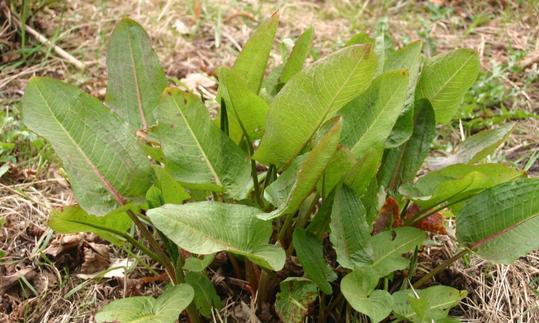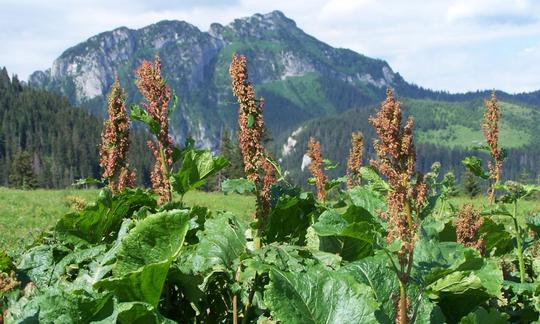Table of contents
Members of the wild plant genus dock ( Rumex spp.) can be used raw as a lemon-sour herb ( organic ?) in the kitchen. Larger quantities of the so-called monk's rhubarb should be blanched and the cooking water, which contains a high amount of oxalic acid, thrown away.
Dock - Use in the kitchen:
Is blunt-leaved dock edible? As is well known, the most popular member of the Rumex genus, sorrel, can be eaten raw. In principle, however, you can also eat the plant parts of the numerous other types of dock. They have a sour and bitter taste to varying degrees. The leaf stalks are the most sour and older leaves the most bitter. By boiling and throwing away the cooking water, a considerable amount of the water-soluble oxalic acid can be reduced. 13 You should use an enameled pot, as bare steel and aluminum pots react with the oxalic acid and can be responsible for a metallic aftertaste.
How can you eat sorrel? Today, very few people find monk's rhubarb tasty. Only sorrel still plays a role in the diet. In Eastern Europe, sorrel soup is a typical spring dish. In England and France, dishes are prepared with this sour-tasting wild vegetable.
The wild plant is used as a substitute for lemon or vinegar - often in raw food. Small amounts of fresh herbs can be added to dishes where a certain acidity is desired. Cut into fine strips, monk rhubarb tastes good raw inleaf salad, cucumber salad, vegan herb curd, dips or sauces. Blanched, it goes well with lentils, potatoes, tomatoes and zucchini in vegetable dishes.
The wild vegetables should be used in reasonable quantities and processed fresh, as the aroma cannot be preserved well, e.g. by drying.
Meadow sorrel ( Rumex acetosa), small sorrel ( R. acetosella), beautiful dock ( R. pulcher), shield dock ( R. scutatus), thorn-flowered sorrel ( R. thyrsiflorus) and blood dock ( Rumex sanguineus) have always been popular as lemon-like sour spices and flavorings. Over the course of the growing season, these species may develop a slightly bitter taste.
Another group with a slightly sour and subtly bitter taste can be used as a vegetable. These species have a high proportion of usable leaf and stem material. These include mountain sorrel ( R. alpestris), garden dock ( Rumex patientia), alpine dock ( R. alpinus) and river dock ( R. hydrolapathum).
There are many Rumex species that are rarely used in food. Therefore, only sparse information can be found in the records. However, these species are not considered to be of concern (more than the others). They include water dock ( R. aquaticus), knotted dock ( R. conglomeratus), vegetable dock ( R. longifolius), bank dock ( R. maritimus), snow dock ( R. nivalis), marsh dock ( R. palustris) and narrow-leaved dock ( R. stenophyllus). Some dock species such as curly dock ( R. crispus) or blunt-leaf dock ( R. obtusifolius) were usually only used in times of need.
Vegan recipe for risotto with sorrel (monk's rhubarb):
Ingredients (for 2 people) : 50 g + 5 g raw sorrel (organic), cut into strips; 150 g risotto rice (wholegrain), soaked overnight and washed well; 300 ml organic vegetable stock ; 1 small onion, chopped; ½ garlic clove, chopped;pepper, freshly ground, and turmeric as needed; 2 bay leaves ; 20 g macadamia nuts, ground.
Preparation: Blanch the raw monk rhubarb (50 g) for 1 minute in an enamel pot and pour away the cooking water with the dissolved oxalic acid. In a second pot, bring the rice (soaked overnight) to the boil together with the vegetable stock, onion, garlic and spices and let the wholegrain rice cook for approx. 40-60 minutes, depending on the instructions on the packet. Finally, stir in the blanched monk rhubarb. Serve the risotto on 2 plates, sprinkled with the raw wild vegetable strips (5 g) and the vegan macadamia "parmesan".
Vegan dock recipes can be found under the note: " Recipes that have the most of this ingredient ".
| Not only vegans or vegetarians should read this: Vegans often eat unhealthily. Avoidable nutritional errors. |
Shopping - where to buy dock?
You will look in vain for raw monk's rhubarb as a vegetable in stores - except for a few varieties, e.g. wild or cultivated sorrel or blood dock (preferably as organic cultivars). We have not yet found the wild vegetable in supermarkets such as Coop, Migros, Denner, Volg, Spar, Aldi, Lidl, Rewe, Edeka or Hofer or in the organic supermarkets Denn's Biomarkt or Alnatura.
Sorrel can be bought seasonally in raw quality (raw food quality) in individual organic shops, health food stores, natural food stores, at the weekly market, directly from the farmer, in greengrocers, online or via a subscription box (seasonal box, green box) - mostly in organic quality.
Found in the wild - Season:
The genus Rumex spp. are perennial, herbaceous plants with upright and branched stems on which the leaves are arranged alternately. The ochrea (tute or leaf boot, also called leaf sheath) at the transition from the stem to the leaf is usually ciliate. The grape-shaped or panicle-shaped inflorescence is usually terminal, sometimes also axillary. The flower consists of a six-leafed perianth with six stamens. The fruit is a three-edged nut. 1 The more than 130 (or up to 200 6,14,15) Rumex species are sometimes difficult to distinguish from one another. The meadow sorrel ( R. acetosa) is probably the most familiar from walks in the lowlands.
Season: The ideal time to collect them is the spring months, when the wild vegetables still taste relatively mild and the young leaves are tender. The plants should not come from over-fertilized meadows and pastures.
Other known species not mentioned above are: Bull's-head dock ( R. bucephalophorus), Canary Island dock ( R. lunaria), Squat dock ( R. confertus), Tangier dock ( R. roseus), Willow-leaf dock ( R. triangulivalvis) or Indian dock ( R. vesicarius).
Storing sorrel:
Raw monk's rhubarb is sensitive to heat and loses its flavor quickly. It can be washed and spun dry and stored in a plastic bag in the refrigerator for a few days. The wild plant is not suitable for drying as it loses a lot of its flavor. A longer-term preservation option is to soak it in oil or water, salt and vinegar (details under small sorrel).
Ingredients - nutritional values - calories:
Rumex plants (raw) have a calorie content of around 22 kcal per 100 g. The main nutrients are around 0.7 g fat, 3.2 g carbohydrates and 2 g protein per 100 g. The contents of minerals, trace elements and vitamins are relatively low, except for vitamin C. Fresh plants have around 48 mg/100g, which would make up 60% of the daily requirement. 2,3
In addition, the herb of Rumex contains secondary plant substances such as flavonoids, 6 hyperoside, carotene, tannins and free oxalic acid. The latter fluctuates greatly over the course of the year. 1,2,3 The roots contain tannins and laxative anthraquinones. 1,4
Raw monk rhubarb has a relatively low protein content (2 g/100g) compared to other edible plant leaves. Mallow leaves with 20 g/100g, moringa leaves with 9.4 g/100g, garlic mustard with 8.6 g/100g or cow parsley with 4.1 g/100g are worth mentioning. 2,3
Fresher wild vegetables that are richer in vitamin C than monk rhubarb are raw garlic mustard (261 mg/100g), raw wild garlic (150 mg/100g) or raw ground elder (140 mg/100g). 2,3
In addition to monk's rhubarb, spinach and rhubarb have significant levels of oxalic acid. The concentration varies in different parts of the plants. The stems of these plants have significantly lower amounts than the leaves. 5
The special sorrel ingredients can be found HERE in the corresponding wild plant description.
The complete ingredients of dock, the coverage of the daily requirement and comparison values with other ingredients can be found in our nutrient tables in CLICK FOR below the ingredients picture.
Healing effects - Health aspects:
Rumex spp. are not scientifically recognized phytopharmaceuticals. Before clinical trials can be carried out on patients, pharmacological studies are required to research the mechanism of action, safety and effectiveness. Due to a lack of scientific data, conventional medicine, in contrast to folk medicine, does not use this plant genus. 6,7
Dangers - intolerances - side effects:
Monk's rhubarb can have harmful effects on the body if consumed in large quantities due to the oxalic acid it contains. Oxalic acid inhibits the absorption of calcium, iron and magnesium. A high intake of foods containing oxalic acid is critical in the case of an unbalanced diet, as this can encourage a mineral deficiency. 5 For sorrel, for example, some sources state an average content of 500 mg oxalic acid per 100 g 5 (but this varies greatly 1,2,3,6). A dose of 5–15 g of pure oxalic acid is considered fatal. 5,6
Special care is therefore required for children, people with kidney disease and people who are prone to urinary stones. The body cannot break down oxalic acid and excretes it through the kidneys. 1,5,6 Pregnant women should avoid using sorrel. 1
Calcium-rich food combinations bind some of the oxalic acid and thereby render it harmless. 1,2,3 Examples of suitable foods for this purpose include sesame and dried herbs such as basil, marjoram, thyme, dill, oregano, rosemary, coriander leaves, fennel seeds, parsley, tarragon or drinking calcium-rich water. Soaking or boiling (and throwing away the cooking water) also reduces the oxalic acid content. 13
In terms of its allergenic potential, monk's rhubarb is classified in the middle of the so-called RAST classes (Radio-Allergo-Sorbent Test) (Rast class 0 = no reaction at all, Rast class 6 = strongest reaction). The pollen content in the air is rather low. 8
Folk medicine - natural medicine:
In traditional medicine, monk's rhubarb is used as a digestive and bile secretion-promoting plant for difficult-to-digest foods. It is used for blood purification, as a diuretic and to strengthen the immune system. Externally, poultices are used to relieve skin ailments and diseases of the oral mucosa. 1
The decoction of roots (e.g. R. aquaticus, R. hydrolapathum) was used internally to treat itching, blood disorders, jaundice, stone disease, skin disorders, swollen glands or internal bleeding. Depending on the tannin or anthraquinone content, the roots were used both to treat diarrhea and as a laxative. Powdered roots of R. aquaticus were used as a dentifrice. They were used against scurvy and ulcers. 1,9,10
Fresh leaves of R. hydrolapathum and R. obtusifolius were used to treat styes and to apply to wounds, burns and blisters (beware of secondary infections!). 1 R. crispus and R. obtusifolius have similar active ingredients. They are traditionally used for skin problems. 10
The seeds were said to have an effect on dysentery, stomach ailments, disgust for food and against scorpion venom. 9
Distribution - origin - ecology:
The more than 130 Rumex species (almost 200 according to the authors 6,14,15) occur mostly in the temperate zones of the Northern Hemisphere.
They prefer to grow on nutrient-rich, heavy and moist loamy and clay soils. Many plants have an extremely high displacement power and the seeds can survive in the soil for several decades. On ecologically managed meadows and pastures, the blunt-leaved dock in particular is a major weed. If it occurs in large numbers, it leads to crop losses and reduced feed quality. 11 On non-sealed surfaces, e.g. meadows or beds, dock can be controlled with salt - but not on sealed surfaces. 12
Growing in the garden or as a pot plant:
Monk's rhubarb needs moist soil in a sunny location or in partial shade. Propagation is done by sowing in spring and dividing in spring or autumn. The leaves should be harvested young and used fresh. The roots can be dug up in autumn and dried for decoctions, liquid extracts and tinctures. 10
If you want to fight the plant, which is considered a weed (especially the blunt-leaved dock), you should prevent it from forming seeds. The most effective (non-chemical) method is to pull it out by hand with a dock fork (black iron, dock puller, see dock puller test). This is a special weed puller that can reach deeper into the soil than a normal one. It is important to remove the roots as completely as possible, as new plants can sprout from leftovers. 1
If you want to grow this invasive and difficult to control wild plant in your garden, tall flower pots are a good option. If you keep it as a potted plant, you have more control over this weed-like, old and forgotten food plant.
Animal protection - species protection - animal welfare:
Monk 's rhubarb has little value as a fodder plant. Is blunt-leaved dock poisonous to horses? Due to the oxalic acid it contains, large quantities can lead to poisoning in ruminants and horses, as it causes a severe reduction in blood calcium levels.
Danger of confusion with monk's rhubarb:
Be careful not to confuse it with the poisonous spotted arum ( Arum maculatum) or with other types of arum ( Arum). Depending on the Rumex species, the leaves are similarly wide. 1 Later in spring, the flowers are the most important distinguishing feature. The arum forms its characteristic flowers close to the ground, while monk's rhubarb flowers grow upwards in panicles and are reddish.
General information:
Sorrel ( Rumex spp.) is a genus of plants in the knotweed family (Polygonaceae). Today, cultivars of meadow sorrel ( R. acetosa) play a major role in nutrition.
Alternative names:
In English, Rumex is called dock or sorrel. The names of known species are alpine dock ( R. alpinus, monk's rhubarb), blood dock ( R. sanguineus), broad-leaved dock ( R. obtusifolius), water sorrel ( R. aquaticus), maritime dock ( R. maritimus) and common sorrel ( R. acetosella and acetosa).
A rather outdated alternative name for Rumex is monk's rhubarb (it can also be specific to R. alpinus). Incorrect spellings are Rumex spp, Anpfer or Ampfe.
Literature - Sources:
Bibliography - 15 Sources
| 1. | Fleischhauer SG, Guthmann J, Spiegelberger R. Enzyklopädie. Essbare Wildpflanzen. 2000 Pflanzen Mitteleuropas. Aarau: AT Verlag; 1. Auflage. 2013. |
| 2. | Diet-health.info Nährstofftabellen. |
| 3. | USDA (United States Department of Agriculture). Nährstofftabellen. |
| 4. | Fleischhauer SG, Guthmann J, Spiegelberger R. Essbare Wildpflanzen. 200 Arten bestimmen und verwenden. Augsburg: Verlagsgruppe Weltbild GmbH; 3. Auflage. 2013. |
| 5. | Ernaehrungs-umschau.de Oxalsäure. Weiss C. 11/09. |
| 6. | Vasas A, Orbán-Gyapai O, Hohmann J. The Genus Rumex: Review of traditional uses, phytochemistry and pharmacology. Journal of Ethnopharmacology. 2015;175:198-228. |
| 7. | Pahlow M. Das grosse Buch der Heilpflanzen. Gesund durch die Heilkräfte der Natur. Hamburg: Nikol Verlagsgesellschaft mbH & Co. KG; 8. Auflage. 2019. |
| 8. | Pollenundallergie.ch Ampfer. |
| 9. | Zotter H. Antike Medizin. Die medizinische Sammelhandschrift Cod. Vindobonensis 93 in lateinischer und deutscher Sprache. Graz: Akademische Druck- u. Verlagsanstalt; 2. Auflage. 1986. |
| 10. | Bown D. Kräuter. Die grosse Enzyklopädie. Anbau und Verwendung. München: Dorling Kindersly; 2. Auflage. 2015. |
| 11. | Oekolandbau.de Stumpfblättriger Ampfer. 2018. |
| 12. | T-online.de Salz und Essig: Verboten als Unkrautvernichter? 10.05.2012. |
| 13. | Chai W, Liebman M. Effect of different cooking methods on vegetable oxalate content. J Agric Food Chem. 20. April 2005;53(8):3027–30. |
| 14. | Powo.science.kew.org Royal Botanic Gardens Kew. Rumex L. |
| 15. | Trelease W. A Revision of the American Species of Rumex Occurring North of Mexico. Missouri Botanical Garden Annual Report. 1892: 74–98. |










Comments